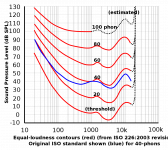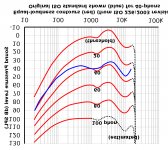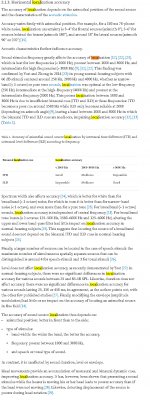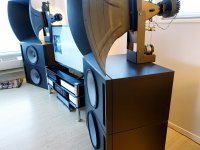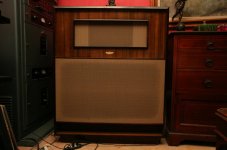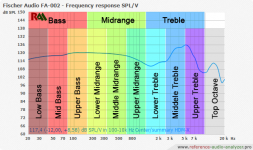What to believe?...... what someone says, or what makes better sense?
Human hearing accuracy peaks at ~1 kHz and peak sensitivity around 4 kHz, so thinking the DRs. Geddes are telling it like it is. 😉
GM
Human hearing accuracy peaks at ~1 kHz and peak sensitivity around 4 kHz, so thinking the DRs. Geddes are telling it like it is. 😉
GM
Gotta say, couldn't disagree more, there is much more going on than where hearing sensitivity peaks
Last edited:
you can look at the equal loudness scale and reverse engineer sensitivity of some degree.....looks at about little before 1000hz to 6000hz to be the most sensitive to spl.....just like a horn, if the ear is sensitive to spl in that area it is going to exaggerate any flaws as well....it would seem...now the brain is pretty complicated so theres more to it than that but 700-7000hz what I read Geddes calling the critical range....now line those numbers up with what I just reversed engineered using logic....one might suggest that the horn that is known as the ear canal? has a resonate note ~3200hz....I present resonate/tuning note and cutoff....
using my approach of reverse engineering, I could say that, the perceived resolution, in this area accompanied by the rise in sensitivity, to spl in the same area, is suggestive that sensitivity and another layer of SQ is intertwined....and that higher sensitivity systems may have have an advantage over lower sensitivity systems based off of that alone.
My hypothesis is that also regarding acoustical haptics, that as ear sensitivity dwindles, lower and lower, our sensitivity to physical vibration offsets that and has an opposite curve of increased sensitivity....
Attachments
Last edited:
can you source where you have read the information regarding localization vs frequency? It was said that we can't localize frequency at certain spectrum? really?
I posted this in the thread on major frequency ranges so I wouldn't forget where I put it.
Sound Source Localization
Another one to keep in mind is that we have difficulty localizing frequencies below 7,000Hz on the vertical axis. I don't know if that means it is beneficial to keep 7,000Hz+ off the ceilings. Sheetrock ceilings might naturally absorb those frequencies, I don't know.
Attachments
thanks for sharing
where ever localization peaks... keep timing issues from THAT place geesh.
where ever spl sensitivity peaks... keep tonal issues from THAT place geesh
Attachments
Last edited:
Wow, this thread has really wandered. Not much about horns or compression drivers anymore. 🙁
Think I'll go build some more horns. You know, real DIY.
Think I'll go build some more horns. You know, real DIY.
looks like some clarification of the psychoacoustics side in order to understand the experience difference between horn and no horn....
polar and sensitivity
polar and sensitivity
Last edited:
Is it pretty much consensus that compression drivers in traditional horns stink for home audio? Good implementation of a home audio compression driver is Earl Geddes' compression driver in a non-traditional type of horn (waveguide) with a foam phase plug. After that might be the JBL M2 image waveguide or equivalent.
Consensus doesn't mean universal acceptance. It means it's the generally accepted position among subject matter experts.
Is that about the gist of it?
Consensus doesn't mean universal acceptance. It means it's the generally accepted position among subject matter experts.
Is that about the gist of it?
I translate that, as the preference for a certain polar performance (wide)...
That preference does not reflect sq, rather not wanting the “head in vice” experience....I think this has been exaggerated unless my math is off...no one is having a head in vice experience with horns under 15” in width which is about a 350hz tractrix for traditional horns....Geddes waveguide is ~15” wise isn’t it? So not all horns are created equal as opposed to application...near field vs mid field vs far field
That preference does not reflect sq, rather not wanting the “head in vice” experience....I think this has been exaggerated unless my math is off...no one is having a head in vice experience with horns under 15” in width which is about a 350hz tractrix for traditional horns....Geddes waveguide is ~15” wise isn’t it? So not all horns are created equal as opposed to application...near field vs mid field vs far field
A very common reason of this is, the room is noisy. Have you ever measured your room's noise floor?
Not so much as the room is ‘noisy’......but the room is a huge part of the system overall.
Remove early reflections and the acoustic smearing of detail is reduced.......and overall improvement in clarity is perceived
Remove excessive low midrange and upper bass room established resonance due to long decay time and...,again......perceived clarity returns.
One thing that everyone often overlooks when considering speakers.......the physical boundaries within the acoustic space are equally important as the speaker itself.........
Remove early reflections and the acoustic smearing of detail is reduced.......and overall improvement in clarity is perceived
Horns reduce early reflections with directivity....
Corner loading speaker reduces early reflections by increasing directivity & reducing the time smear
Soffit Mounting reduces early reflections by its proximity to the plane its on and increased directivity....
Soffit mounted and corner loaded horn systems for the win?
What about a Soffit mounted Dynamic system vs a horn system like Joes? Still no cigar?
Last edited:
Wow, this thread has really wandered. Not much about horns or compression drivers anymore. 🙁
Think I'll go build some more horns. You know, real DIY.
+1
Is it pretty much consensus that compression drivers in traditional horns stink for home audio? Good implementation of a home audio compression driver is Earl Geddes' compression driver in a non-traditional type of horn (waveguide) with a foam phase plug. After that might be the JBL M2 image waveguide or equivalent.
Consensus doesn't mean universal acceptance. It means it's the generally accepted position among subject matter experts.
Is that about the gist of it?
Is a "traditional horn" an old PA horn? I recently saw a post here from a guy who has been using some JBL 2360 horns in his home stereo and appears to be quite pleased, the recent changes he made were to the bass bin portion:
https://www.diyaudio.com/forums/multi-way/320468-jbl-baffle-horn-speaker-okob-5.html#post6437486
Good implementation of a compression driver for home audio could be any of the recent JBL compression driver/horn consumer speakers,
4367,
4429,
DD67000
1400 Array
or even some of the more budget oriented items like the Studio 590
Properly implemented, there's nothing inherently wrong with compression drivers. Poorly implemented compression drivers are a different story.
Attachments
Last edited by a moderator:
Totally bollocks. Look at the Shindo speakers, very traditional systems that employ famous Westrex and Altec components.Is it pretty much consensus that compression drivers in traditional horns stink for home audio?
Is that about the gist of it?
The original Westrex horn speaker was made for home audio listening, too.
My horn speakers put the woofer in a horn cab, otherwise the same speaker.
Works like a charm.I would prefer those every day in the life. With an excellent horn, no cone speaker can compare.
Attachments
Last edited:
I translate that, as the preference for a certain polar performance (wide)...
That preference does not reflect sq, rather not wanting the “head in vice” experience....I think this has been exaggerated unless my math is off...no one is having a head in vice experience with horns under 15” in width which is about a 350hz tractrix for traditional horns....Geddes waveguide is ~15” wise isn’t it? So not all horns are created equal as opposed to application...near field vs mid field vs far field
I've read the problem with horns is they have honky sound like when you cup your hands over your mouth to amplify your voice. I think Geddes described it as high order modes (HOMs) generated at the edge of the pressure wave that makes contact with the horn.
His waveguide shape is designed to reduce -- to the maximum mathematically possible -- the HOMs that create the honky sound. Then he added the foam phase plug to eliminate the residual.
The Dutch and Dutch 8c uses the same shape of the Geddes waveguide but with a direct radiator rather than a compression driver and without a foam phase plug.
If I understand correctly there's a difference in the wave shape generated by a compression driver compared to a direct radiator like the tweeter in the D&D 8c.
I think the decision process is whether or not you're going to use a horn to control directivity. Then will you use a compression driver or a direct radiator.
So I think it boils down to whether compression drivers or direct radiators sound better in waveguides and under what circumstances.
Here are some observations / opinions on why my horn system performs as well as it does, despite some of the "techno-babble" I have seen here.
Driver selection: The Low midrange, I originally had 2441 JBL drivers, with original diaphragms. I then replaced the original diaphragms with Truextent beryllium diaphragms. This was an expensive but worthwhile upgrade, more extension, more detail. Also had TAD 4002 drivers which were also very good. From there I went to the Classic Audio field coil driver with beryllium diaphragms, which I feel is as good as it gets. Dr. Bruce Edgar gave me a 20 minute lecture ( which went right over my head) on why field coil drivers are superior to fixed magnet drivers. I will not even try to explain this here, but it does give me some flexibility dialing in the sound by changing the power supply voltage.
The upper midrange driver : a custom design field coil driver made by Jeffrey jackson and Dave Slagle using a JBL beryllium diaphragm. Only a pair or two are in existence.
Tweeter: I have tried the Fostex T500mk2 and it is excellent, also a Sequerra T1mk4 tweeters, good but too low sensitivity ( for my use), same with Raven R2 ribbons. The best is the TAD ET-703, a great match, high sensitivity, beryllium diaphragm. Now, as rare as hens teeth and expensive if you do see them for sale.
IMHO you must have a mid bass horn, that is high sensitivity, that closely matches the other drivers. This is where most horn systems fall flat. This is why I used 2 Altec 515b's in parallel. If you have to pad down all of your compression drivers to match your mid bass horn / box speaker, IT IS A TOTAL WASTE OF POWER and sucks the life out of the compression drivers by adding all the additional passive crossover parts !!! This doesn't mean you can't get good sound but you will not get the speakers full sound potential. Adding active crossovers, amplifiers, cables, DEQX, etc. makes things worse--I have tried. A simple, high quality, 6db crossover sounds the best--IN MY SYSTEM--with the drivers I use !!! YMMV.
Time alignment: All the drivers voice coils are in line within 1/8", with the exception of the subwoofers.
Hope this information helps some of the compression driver / horn lovers here !!!
Best regards,
Joe
Driver selection: The Low midrange, I originally had 2441 JBL drivers, with original diaphragms. I then replaced the original diaphragms with Truextent beryllium diaphragms. This was an expensive but worthwhile upgrade, more extension, more detail. Also had TAD 4002 drivers which were also very good. From there I went to the Classic Audio field coil driver with beryllium diaphragms, which I feel is as good as it gets. Dr. Bruce Edgar gave me a 20 minute lecture ( which went right over my head) on why field coil drivers are superior to fixed magnet drivers. I will not even try to explain this here, but it does give me some flexibility dialing in the sound by changing the power supply voltage.
The upper midrange driver : a custom design field coil driver made by Jeffrey jackson and Dave Slagle using a JBL beryllium diaphragm. Only a pair or two are in existence.
Tweeter: I have tried the Fostex T500mk2 and it is excellent, also a Sequerra T1mk4 tweeters, good but too low sensitivity ( for my use), same with Raven R2 ribbons. The best is the TAD ET-703, a great match, high sensitivity, beryllium diaphragm. Now, as rare as hens teeth and expensive if you do see them for sale.
IMHO you must have a mid bass horn, that is high sensitivity, that closely matches the other drivers. This is where most horn systems fall flat. This is why I used 2 Altec 515b's in parallel. If you have to pad down all of your compression drivers to match your mid bass horn / box speaker, IT IS A TOTAL WASTE OF POWER and sucks the life out of the compression drivers by adding all the additional passive crossover parts !!! This doesn't mean you can't get good sound but you will not get the speakers full sound potential. Adding active crossovers, amplifiers, cables, DEQX, etc. makes things worse--I have tried. A simple, high quality, 6db crossover sounds the best--IN MY SYSTEM--with the drivers I use !!! YMMV.
Time alignment: All the drivers voice coils are in line within 1/8", with the exception of the subwoofers.
Hope this information helps some of the compression driver / horn lovers here !!!
Best regards,
Joe
"IMHO you must have a mid bass horn..."
This is an example of why the techno-babble matters. Mid-bass is 50-70Hz which is well within the modal region of small rooms. Directivity, via horn or another method, does bupkis in this frequency region.
Similarly, this is why the psychoacoustics of frequency ranges matter. Let's say we're dealing in the low/mid range of 200-500Hz, the sparse modal region where boundary effects dominate. Should we use a horn in this range to mitigate boundary problems? We can use a horn. But at the cost of a horn that is 2 to 5 feet wide + depth determined by angle of directivity. From what I understand, the psychoacoustics of localization would not justify a horn in this frequency region -- especially in a small room.
Instead, I'd look toward a more compact method to deal with boundary and sparse modal effects. Sometimes it can be as non-invasive as EQ. If a massive horn actually added value in a frequency range then sure, build that bad boy.
This is an example of why the techno-babble matters. Mid-bass is 50-70Hz which is well within the modal region of small rooms. Directivity, via horn or another method, does bupkis in this frequency region.
Similarly, this is why the psychoacoustics of frequency ranges matter. Let's say we're dealing in the low/mid range of 200-500Hz, the sparse modal region where boundary effects dominate. Should we use a horn in this range to mitigate boundary problems? We can use a horn. But at the cost of a horn that is 2 to 5 feet wide + depth determined by angle of directivity. From what I understand, the psychoacoustics of localization would not justify a horn in this frequency region -- especially in a small room.
Instead, I'd look toward a more compact method to deal with boundary and sparse modal effects. Sometimes it can be as non-invasive as EQ. If a massive horn actually added value in a frequency range then sure, build that bad boy.
Attachments
I've read the problem with horns is they have honky sound like when you cup your hands over your mouth to amplify your voice. I think Geddes described it as high order modes (HOMs) generated at the edge of the pressure wave that makes contact with the horn.
When you cup your hands on your mouth you will be amplifying a small range of frequencies from your voice. This can easily give a 'honky' or bright sound.
This is why nearly everybody who uses horns that has posted on this thread has stated that you need to carefully apply EQ to the driver / horn combo for best results.
I sure I've read somewhere that Geddes said that HOMs are only a problem at high output levels. Reading DIYA threads about HOMs would make you think that every non oblate spheroid horn is full of some sort of high frequency hash noise / honk etc...
A lot of the 'honk' talk seems( to me at least) to originate from live sound forums where the speakers are being given a proper beating. At home it is hard to play them loud enough to get close to the levels they would be used at for PA.
I think Joe meant you need to use a Midbass horn to level match with the rest of the horn drivers (Wouldn't need to pad the mids / tweeters down) He didn't mention anything about directivity / room interaction.
Fwiw I use midbass horns in my system, but have had excellent results with ported 15's too. (I run digital xo's so have no need to level match)
Fwiw I use midbass horns in my system, but have had excellent results with ported 15's too. (I run digital xo's so have no need to level match)
- Home
- Loudspeakers
- Multi-Way
- Does anyone else think compression drivers sound bad?
